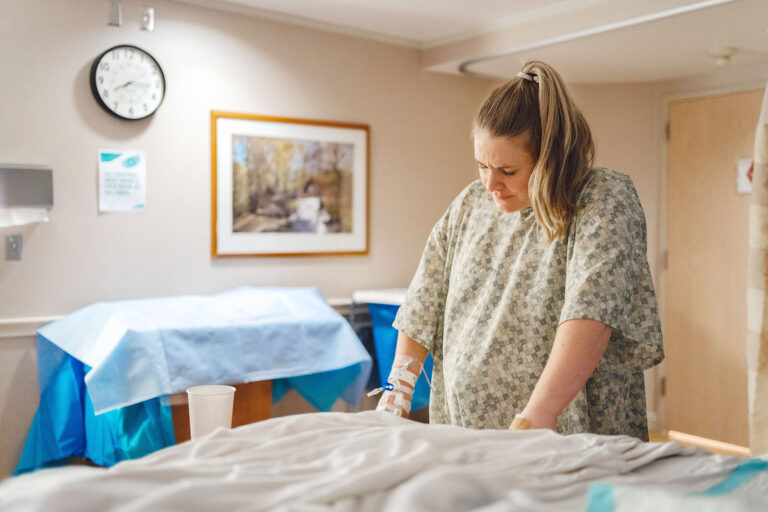So you’ve had a baby through the sunroof, and now you’re ready for your next one to exit through the lobby. Awesome! Here’s all you need to know about preparing for and having a VBAC….vaginal birth after cesarean.
What is a VBAC?
A VBAC is just what it stands for: vaginal birth after c-section. For example, having a c-section with your first child and then giving birth vaginally to your second child.
Here’s the good news — VBACs are generally safe, and recent medical literature supports their use. There are risks, however, and I’ll explain those in a minute
The even BETTER news is that you can prepare your body and pelvic floor for vaginal delivery, just like you would do if you had never had a c-section (more on this later).
See Also

Why consider VBAC?
Deciding what type of delivery is for you is a personal and medical decision, and there are lot of factors that are in play. Most women want to try for a VBAC because they simply want to have the experience of a vaginal birth, and that is reason enough.
Other benefits of having a VBAC are no need for surgery, less hospital stay, possibly easier recovery (although questionable IMO if there is a large tear or trauma during delivery), less risk of infection, and less blood loss.
What are the risks of vaginal birth after c-section?
So let’s get to the elephant in the room: The biggest risk of having a VBAC is uterine rupture, which is life-threatening to both baby and mama.
This can happen due to scar tissue that forms from previous c-sections — during labor, the contractions of the uterus are too much for the scar tissue to manage. The end result is the uterine wall rupturing or tearing, which causes hemorrhaging. This is rare, but must be considered.
If your doc suspects you are at a risk for this, a TOLAC/VBAC will not be permitted, and usually a scheduled c-section will be appropriate (which is awesome! yay advances in medicine to help us have healthy, happy mamas and babies!)
Other risks, according to ACOG, are blood loss and infection, but with any delivery, you can have increased blood loss or infection.
The GOOD news is this: studies show that VBACs tend to have a 60-80% success rate, which is awesome. The National Institute of Child Health and Human Development showed that about 75% of VBAC attempts are successful.
Who is eligible for a VBAC?
Each individual case needs to be evaluated and discussed with a qualified medical provider, but GENERALLY speaking, there are some predictors of a successful VBAC.
Here are some of the predictors of a successful VBAC:
- A previous vaginal delivery
- Having had two or fewer C-sections
- No previous uterine rupture
- Having a low transverse scar (also known as the “bikini scar”- it is horizontal and low, usually where your pubic hair is)
- No previous large abdominal scars
- Past successful VBAC
Some other interesting data shows the majority of VBACs will be succesful with twins or multiple gestations, pregnancies that are less than 24 months apart, and large babies (called fetal macrosomia).
What you can do to prepare for a VBAC (if you are eligible)
Preparing for VBAC takes just a bit more prep work compared to someone who has not had a c-section. However, before you GET pregnant, it’s important to make sure you have given your scar proper rehab, and it’s not bothering you. We want to make sure that the scar is mobile, not sensitive, and not affecting muscle performance.
The second thing you need to have figured out, before labor, is your Plan B. It’s always helpful, not to mention taking a whole lot of stress away, to understand what COULD happen and why, and to be prepared for it. For example, knowing your doctor’s and hospital’s decision-making process for VBAC and moving to c-section is very important, so you know what to expect and can be an active participant in the decision-making process.
Third: Birth Prep is crucial. You want to prepare your body, specifically your pelvic floor, for this birth. You haven’t had a vaginal delivery before, so maybe your pelvic floor needs help figuring out how to lengthen and bear down. We teach all of this in our birth prep course, Elevate Your Birth , to make sure you KNOW how to push, bear down, prep your pelvic floor to reduce risk of tearing and trauma, and what positions are the best for you to labor and deliver in.
Some last words of advice
The most important takeaway is this — be flexible, be prepared, and know that MOST VBACs are successful.
If you know the risks and have an open and honest discussion with your provider about your personal risks and prognosis, you will be well-equipped for whatever scenario presents itself.
And you know what? If you go for a TOLAC and wind up having a c-section, that’s ok! You didn’t “fail” a TOLAC or have a “failed VBAC”. Words matter and you didn’t start off failing. You did awesome! And we are lucky we have options, like c-sections, to keep moms and babies healthy and safe.
Once you’re home and recovering, give us a call so we can help you back on your feet so you can enjoy that baby.











